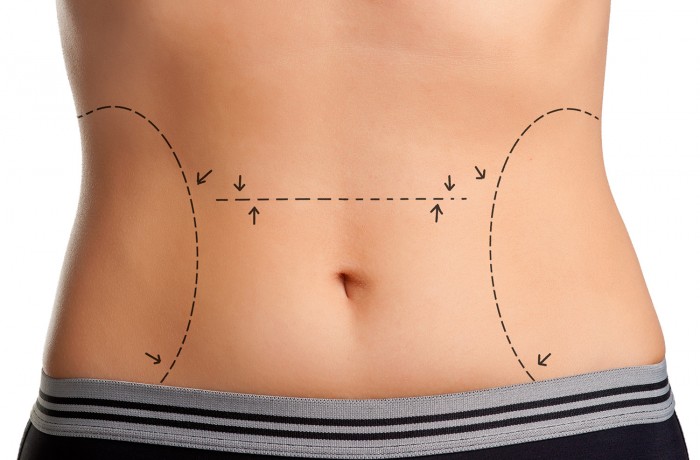People are sometimes left with empty hanging folds of skin after pregnancy, serious weight loss, or sometimes just with aging. When this loose skin is surgically removed from the belly, it is called Abdominoplasty or tummy tuck or body contouring. When the skin is removed around the whole waist to raise the buttock, lateral thighs and trim the tummy, it is called body lifting. From the upper arms, we call it brachioplasty. Thigh lifting is for loose inner thigh skin or posterior thigh skin. Tummy tuck in Toronto is designed to tighten loose and flabby skin. Body contouring cosmetic surgery changes the texture of the skin by stretching it thereby making the looseness and wrinkling less apparent. Body contouring surgery may be combined with liposuction. Liposuction is designed to improve fat bulges and sometime also improve skin tightening and texture when done in specific way.
As with liposuction, body contouring surgery is not intended to correct obesity; patients should try to have as normal or near-normal weight before surgery.
Although tummy tuck surgery is sometimes done under local anesthesia, most other body contouring surgery requires general anesthesia. Loose skin cannot be removed without leaving scars, and body contouring often means long incisions that result in long scars. We will make every effort to give you the best scars possible, and to conceal them in the least visible areas.
We will advise you during your consultation about the type of scar you are likely to get following your Toronto tummy tuck procedure. Although scars will fade over time, you should know, that the scars will be permanent and that their final width, height and color are not entirely predictable.
The most common complications of body contouring surgery are hematoma (an accumulation of blood under the skin), seroma (fluid accumulation under the skin) and numbness of the skin. Most of the feeling usually comes back. Hematoma and seroma may require intervention to drain the blood or serum that has accumulated if it is a large amount. Problems with healing after surgery are also possible, especially if you are a smoker.
Normal activities can usually be resumed within a couple of weeks and many people return to work the third week after surgery.
BENEFITS
Below are a few of the many reasons why patients consider a tummy tuck procedure:
- An inherited condition that causes excess skin and fat in the abdominal area.
- Pregnancy that has stretched the skin and separated the muscles in the stomach area.
- The loss of a significant amount of weight resulting in extra skin.
- Simple aging that can produce unwanted abdominal fat and excess skin.
SIDE EFFECTS
- Temporary pain.
- Swelling.
- Soreness, numbness of abdominal skin.
- bruising.
- Tiredness for several weeks or months.
SAFETY & RISKS
The risks associated with tummy tucks can be minimized by following the physician's recommendations. Smokers should stop smoking well before the surgery. For patients on an aspirin regimen ortaking anti-inflammatory drugs, discontinuingthe treatments is advised, as they can thin the blood, which may result in surgical complications. Persons with other health concerns, such as diabetes, that may inhibit the healing process, should discuss these matters with their doctor. Fluid drainage can also be a challenge and may require extra visits to the doctor. More severe possible complications include blood clots, numbness in the skin, deep vein thrombosis, persistent pain and swelling in the legs and nerve damage. Patients considering an Abdominoplasty are wise to discuss their past and current medical history with their doctor, and ask detailed questions about the procedure before deciding to undergo surgery.
- Blood clots.
- Infection.
- Bleeding under the skin flap
- Poor healing resulting in conspicuous scarring or skin loss.
- Need for a second operation.
RECOVERY
After surgery, the hospital stay is short, typically one to two days followed by recovery at home for about a week. The patient will likely experience pain or soreness in the abdomen and near the incision area, and is given a prescription for pain and medication to prevent infection. The swelling and bruising that may occur after the surgery will subside. Patients should get out of bed and walk around for short periods of time, so that blood circulation stays healthy, and to quicken the healing process. While walking is advised, care must be taken not to strain theabdominal muscles. This means no lifting, and limited bending and stretching. The use of compression garments around the waist that support the abdomen is recommended, however the bandages around the incision area must be changed regularly. Stitches are removed approximately one to two weeks following the surgery, after which, patients should be able to resume most of their routine activities.
- Back to work: 2 to 4 weeks.
- More strenuous activity: 4 to 6 weeks or more.
- Fading and flattening of scars: 3 months to 2 years.

